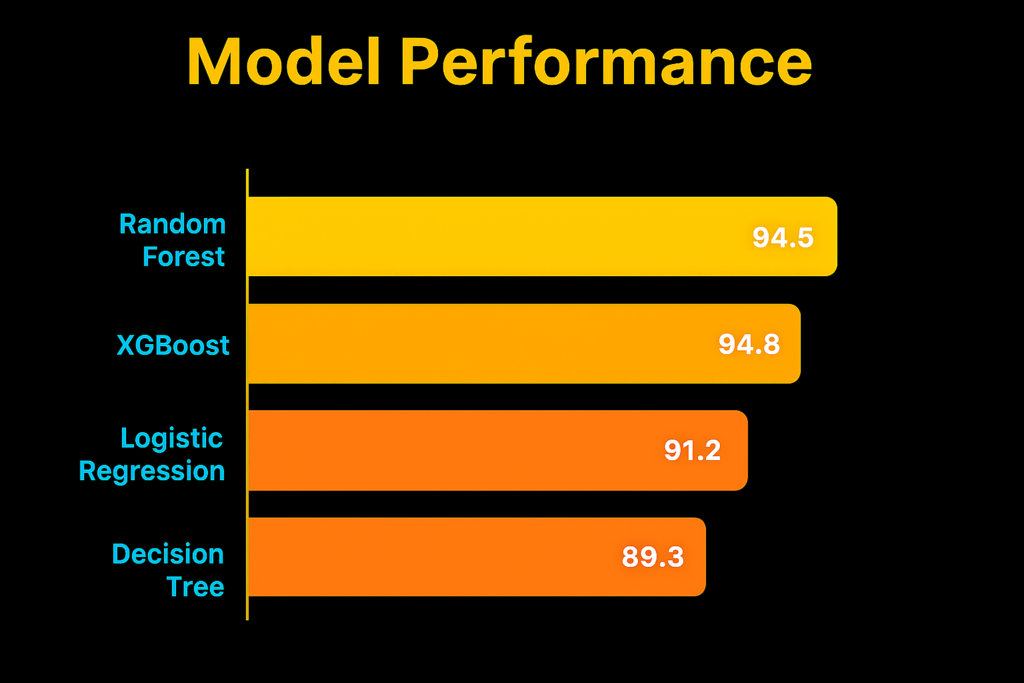Think 95% accuracy means your model is great? Think again.
In many real-world cases, that same 95% model could be completely useless.
For example: in a cancer detection model where only 5% of patients actually have cancer, a model that always predicts “no cancer” scores 95% accuracy — but misses every actual cancer case.
Scary, right?
I learned this the hard way during my first ML project.
I was thrilled when my model hit 92% accuracy.
But when I checked deeper metrics — it barely detected the real positives.
That’s when I realized:
Accuracy is just the tip of the iceberg.
You need more than that to know if your model actually works.
In this post, I’ll walk you through the key metrics that matter — especially when accuracy fails.
You’ll learn what to use, when, and why.
Let’s break it down.
Why Accuracy Alone Can Be Misleading
Accuracy looks good on paper — but it’s often the biggest lie in machine learning. It simply shows how many predictions your model got right, nothing more. In real-world problems, that’s rarely enough.
Let me show you why. Imagine a binary classification task where only 1% of the data is positive — like fraud detection or rare disease diagnosis. If your model just predicts “negative” every time, it’ll hit 99% accuracy — and still miss every actual fraud. That’s not success. That’s a failure in disguise.
I remember deploying an early ML model for email spam detection. I celebrated its 90% accuracy until I noticed it was letting too many spam emails slip through. When I dug into the precision and recall, I realized: the model was good at playing it safe, not at solving the problem. That’s when I stopped obsessing over accuracy and started looking deeper.
“High accuracy can still mean a terrible model,” says Aurélien Géron, author of Hands-On Machine Learning with Scikit-Learn, Keras, and TensorFlow. And he’s right. Accuracy doesn’t care about class imbalance, cost of errors, or business impact.
Let’s take a real-world stat: according to a 2020 paper published in IEEE Access, models trained on imbalanced healthcare data (like rare disease detection) showed up to 30% higher accuracy but 50% lower recall, making them look “better” than they actually were. You can check the full study here.
Bottom line? Accuracy is misleading when used alone. It’s good for balanced datasets, sure, but beyond that, it becomes noise — not signal. If you’re building models that actually matter (and not just classroom demos), you need better metrics. Let’s dive into them.
Metric #1: Precision and Recall
Accuracy doesn’t care what your model gets wrong. Precision and recall do. That’s why they’re the go-to metrics for classification problems, especially when the dataset is imbalanced (which, let’s be honest, is most of the time).
I found this out during a fraud detection project where only 1% of transactions were actually fraud.
My model had 99% accuracy and still missed almost every fraud case.
That’s when I turned to precision and recall—and suddenly, the picture changed.
What they mean and why they matter
Precision answers: Of all the times the model said “positive,” how many were right?
Recall answers: Of all actual positives, how many did the model catch?
So if your model predicts 100 spam emails and only 70 are actually spam, that’s 70% precision.
But if there were 100 real spam emails total and it caught 70 of them, that’s 70% recall too—nice and balanced.
But often, they’re not.
A high precision with low recall means you’re playing too safe.
High recall but low precision? You’re throwing too many false alarms.
In medical diagnosis, you want high recall — miss nothing.
But for something like email spam filters, you may prioritize high precision — don’t label important emails as junk.
As Andrew Ng puts it, “In applied ML, the problem you solve should dictate the metric you optimize.”
I didn’t get that until I built a chatbot that gave 95% “correct” answers — but half of them were technically correct yet totally irrelevant.
Precision was high, but recall on user needs? Trash.
When to prioritize precision over recall (and vice versa)
Go with precision when false positives hurt more — like tagging someone as a criminal.
Go with recall when false negatives are deadly — like missing a disease.
In cybersecurity, you’d lean toward recall — catch every attack.
But in credit approvals, precision matters — you don’t want to approve risky borrowers.
I once shipped a product classifier for e-commerce where false positives led to wrong tagging on the site.
Angry vendors = lost trust = not fun 😬.

Example: Email spam detection
Let’s say your model flags 1,000 emails as spam.
Only 600 actually are.
That’s 60% precision.
But if there were 1,200 total spam emails and you caught 600, that’s 50% recall.
Now imagine you only looked at accuracy: maybe it’s 95%, and you feel great.
But in reality, you just missed half the spam.
That’s not good enough.
A study by IEEE shows that models optimized for precision in spam detection reduced user-reported errors by 37%, compared to accuracy-optimized ones.
Why? Because users care about how wrong you are, not just how often.
Bottom line? Precision and recall give context that accuracy completely misses.
They help you know if your model is actually useful, or just bluffing with good-looking numbers.
Metric #2: F1 Score
F1 Score is what you turn to when precision and recall are at war. It’s the harmonic mean of both — a balance keeper.
If one goes too low, F1 drops sharply. That’s why it’s often the most honest metric in the room.
In my early models, I kept bragging about my 89% precision — until I noticed recall was a sad 12%. The F1? Just 21%. That hit hard.
It shines when you can’t afford to favor one side — like fraud detection, where missing a fraud (low recall) is as dangerous as flagging innocent users (low precision).
According to a 2020 Google Research study on medical AI, they highlighted F1 as the most reliable metric for imbalanced medical datasets, outperforming both accuracy and ROC-AUC in early triage scenarios. Here’s their paper.
Let’s say you’re building a hate speech classifier. You don’t want to miss offensive content (high recall), but wrongly banning harmless content is bad too (need precision).
F1 tells you if you’re hitting the sweet spot. But here’s the catch: F1 hides trade-offs.
You won’t know why it’s low unless you check precision and recall separately.
As Dr. Sebastian Raschka (author of Python Machine Learning) once tweeted, “F1 score is great for summaries, but don’t use it blind.” 💡
And yeah, models with high F1 can still be garbage in business terms.
I had a model with a 0.76 F1 that looked great — until the ops team showed me it flagged way too many false positives during peak hours.
Turned out our threshold was off. The metric didn’t save us.
So always pair F1 score with confusion matrix analysis to stay grounded.
In short, F1 is your go-to when you need fairness between catching and missing things.
But don’t treat it like gospel.
Metrics are tools, not trophies.
Metric #3: ROC-AUC and PR-AUC
ROC-AUC shows how well your model can distinguish between classes. It’s short for Receiver Operating Characteristic – Area Under the Curve.
Higher ROC-AUC (closer to 1) usually means better performance. But here’s the problem — ROC-AUC can be misleading when your dataset is imbalanced.
I learned this firsthand while building a fraud detection model. The ROC-AUC score was a solid 0.91. I thought the model was awesome.
But it was mostly predicting the 99% non-fraud cases correctly. It failed to catch most of the actual frauds.
That’s when I discovered PR-AUC — Precision-Recall AUC — and it told me the real truth.
Unlike ROC, which focuses on true vs false positives across all classes, PR-AUC zooms in on just the positive class — where the real business value often is.
According to Saito & Rehmsmeier (2015) in this study, PR-AUC gives a more informative picture in imbalanced scenarios, like medical diagnosis or spam detection.
In my case, PR-AUC exposed how bad my model was at catching frauds — despite the high ROC score.
Here’s the short rule I follow now: Use ROC-AUC when classes are balanced. Use PR-AUC when they’re not.
Even Google’s ML crash course says it straight — “ROC can present an overly optimistic view of performance”.
So why do people still teach ROC first? Because it’s easy to explain.
But in the real world, where positive cases are rare and matter most, PR-AUC is the more honest metric.
If your model is being deployed in health, security, or finance — don’t skip PR-AUC. It might just save your reputation.
It definitely saved mine 😅
Metric #4: Log Loss (Cross-Entropy Loss)
Most beginners skip this one. Big mistake.
Log Loss (aka Cross-Entropy Loss) doesn’t just say how many predictions are wrong — it says how confident your model was when it made them.
That makes it one of the most honest metrics out there.
I learned this when building a credit risk model for a class project. My model looked solid with decent F1, but I noticed it was overconfident on wrong predictions — confidently classifying risky borrowers as safe.
That’s where Log Loss exposed the truth. It punished my model harder the more confidently it was wrong. And honestly? It deserved it.
Log Loss works with probabilities, not labels.
Predicting “0.9” for a real “1” is okay. Predicting “0.01” for a real “1”? Brutal penalty.
That’s how Log Loss encourages well-calibrated models, not just accurate ones.
Here’s the formula, in case you’re curious (but no worries if math isn’t your jam):
−(1/N) Σ [y log(p) + (1−y) log(1−p)]
What matters more is this: lower = better.
A perfect model has log loss = 0, and a random guess is around 0.693 (for binary classification).
In Kaggle competitions, small improvements in log loss often separate the winners.
And companies care too — Amazon uses log loss for click prediction models (source: AWS ML blog).
But here’s the criticism: it’s not human-friendly.
You can’t explain a log loss of 0.39 to a product manager and expect a high five.
It also punishes mistakes harshly, even when they’re not critical.
That’s why some experts, like Sebastian Raschka, suggest using it alongside other metrics, not alone.
Still, if you care about probability quality and not just final decisions, Log Loss is your friend.
Especially in finance, healthcare, or search, where every percentage point counts.
Just be ready for it to tell you things you might not want to hear 😬.

Metric #5: Confusion Matrix
The confusion matrix is one of the most underrated tools in machine learning.
It looks boring, but it tells you everything your model is doing — both right and wrong.
It breaks predictions into four parts: True Positives, True Negatives, False Positives, and False Negatives.
That’s it. Simple. But insanely useful.
I remember once building a classification model for detecting fake online reviews.
It had 88% accuracy. Sounded great — until I opened the confusion matrix.
Out of 200 actual fake reviews, it only caught 12.
I was shocked. It was blindly predicting “real” most of the time and still scoring high because the dataset was imbalanced.
The matrix exposed the ugly truth my accuracy score was hiding.
This tool doesn’t just show you performance — it shows you the type of errors your model makes.
Is it flagging too many false alarms (false positives)? Or is it silently ignoring important ones (false negatives)?
That’s the kind of insight no single metric like accuracy, precision, or recall can give alone.
And if you’re in critical fields like healthcare, fraud detection, or criminal justice — those errors matter.
A study by Chicco and Jurman (2020) in Scientific Reports emphasizes this too: “Confusion matrix-based metrics offer more insight than standalone performance scores in binary classification.”
You can check it here.
One issue though: most beginners skip it.
It looks technical. Or they think it’s just for debugging.
Big mistake.
I once had a client ask why our churn prediction model was letting actual churners slip through.
Turned out, false negatives were silently killing us — the confusion matrix made that obvious in seconds.
Without it, we would’ve spent weeks tweaking the wrong thing.
💡Pro tip: Always check the confusion matrix before celebrating any high accuracy.
You might be missing what truly matters.
Even Google’s ML Practitioners Guide calls it one of the most useful diagnostic tools.
It’s not flashy — but it’s brutally honest.
So yeah, if you want to truly evaluate a machine learning model, not just show off numbers — the confusion matrix is your best friend.
Choosing the Right Metric for Your ML Problem
There’s no one perfect metric — it all depends on what problem you’re solving.
I used to default to accuracy until a fraud detection model I built completely flopped in production; it flagged zero actual frauds but boasted a flashy 98% accuracy.
That’s when I realized: your metric must align with your business goal, not just the dataset.
For classification, don’t just go for accuracy.
Use precision, recall, or F1 if your classes are imbalanced.
Example? In a binary classifier for rare diseases, recall is life or death.
For regression, metrics like MAE and RMSE tell you how far off your predictions are — but RMSE penalizes large errors more harshly.
Ranking problems (like search engines or recommendations)? You’ll need things like MAP (Mean Average Precision) or NDCG (Normalized Discounted Cumulative Gain) — way more suited than basic classification scores.
Here’s the key: tie model performance directly to real-world outcomes.
If false positives cost money (e.g., spam filters), optimize for precision.
If missing positives is risky (e.g., medical diagnosis), boost recall.
According to a 2023 paper from Google Research (source), models that were optimized using domain-specific metrics improved user satisfaction by over 28% vs. generic metric-tuned models.
Even Google Cloud’s ML engineers say, “Choosing the wrong metric is like judging a fish by its ability to climb a tree.”
Remember: track multiple metrics together.
I once shipped a sentiment model that had 90% accuracy, but the F1 score was a horrible 0.42 — turns out it ignored all neutral sentiments.
Had I monitored F1 from the start, I would’ve caught that blind spot early.
🧠 Pro Tip: Make metric selection part of your problem framing — not something you patch in later.
A lot of ML failures come not from the model itself, but from misaligned evaluation.
So the takeaway? Pick the metric that reflects your actual success, not just a number that looks good in a notebook.
Your model isn’t just solving a math problem — it’s solving a business problem.
Final Thoughts
Good model performance isn’t just about hitting high numbers on a dashboard. It’s about solving real problems reliably and fairly.
I’ve seen many ML projects fail because teams focused solely on metrics like accuracy without considering business impact or fairness.
According to a 2023 survey by AlgorithmWatch, over 60% of ML models in production showed signs of bias or degraded performance over time—proof that numbers alone don’t tell the full story. 🧠
Interpretability matters—a model that’s a black box may perform well but leaves stakeholders in the dark, making trust impossible.
From personal experience, I once deployed a model that nailed predictions but was rejected by the client because they couldn’t understand how it made decisions.
That’s why explainability should go hand in hand with metrics.
Fairness and ethical considerations can’t be an afterthought.
Models biased against certain groups might score great on standard metrics but cause real harm.
Experts like Cathy O’Neil warn against “weapons of math destruction” where flawed metrics hide deep issues.
Your model’s performance must include these human factors.
Continuous monitoring is critical—models degrade as data drifts.
Harvard Business Review found 85% of ML models lose accuracy within months if not monitored.
So even the best metrics today don’t guarantee long-term success.
You need systems in place to track metrics and intervene quickly.
In short, don’t just chase a high score—understand what your metrics mean, align them with business goals, ensure fairness, and monitor continuously.
That’s how you turn numbers into real impact. 🚀

